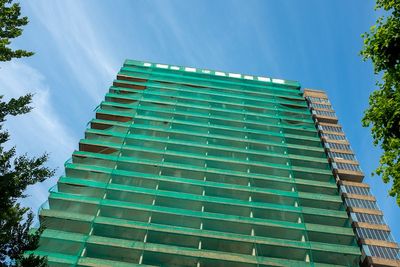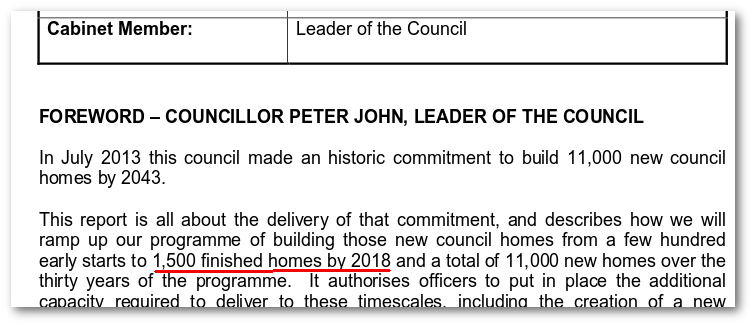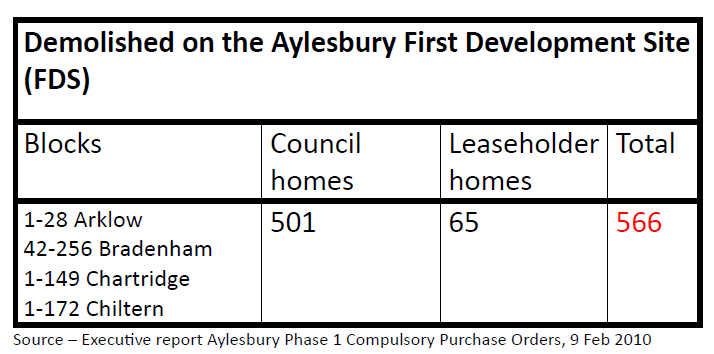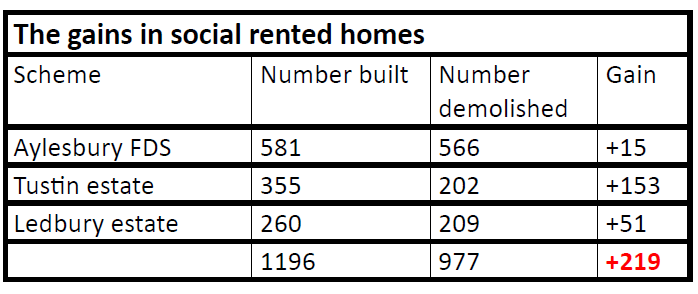
Southwark Council recently ended the ‘direct delivery’ of new council housing, the main strand of its council house building programme and will now rely upon private developments to fulfil its pledge to build 11,000 new council homes. A July Cabinet update report says that 1,486 have been completed and construction of 3,057 council homes has begun[^1]. Southwark's 2020 target was to have at least 2,500 council homes built or under construction by 2022[^2].
What Southwark Council promised
Southwark Council made the pledge to build 11,000 council homes over 30 years, in July 2013. Southwark reiterated the pledge in 2014, emphasising that the new homes would be in addition to current council housing stock, not instead of demolished council housing. The then Council Leader Cllr Peter John wrote in an open letter to residents ‘To be absolutely clear, the 11,000 new homes that we promise to deliver will be new homes additional to our existing stock’.
 "From ‘Delivering our promise to build 11,000 new council homes: An open letter from Councillor Peter John, Leader of Southwark Council’. 19 Sept 2014."
"From ‘Delivering our promise to build 11,000 new council homes: An open letter from Councillor Peter John, Leader of Southwark Council’. 19 Sept 2014."
Cllr John was refuting the charge that the 11,000 new homes would simply replace 11,000 demolished homes. We can see now, ten years later, that while 11,000 council homes have not been demolished, many have been, and when these are taken into account the number of 'additional' council homes is much lower than the 1,486 homes that Southwark claims. It is also lower than the 1,500 target set in 2014 (to be achieved by 2018, not 2024).
 "From Cabinet report ‘Next Steps on Developing Long Term Plans for the Delivery of New Council Homes’ 22 July 2014 "
"From Cabinet report ‘Next Steps on Developing Long Term Plans for the Delivery of New Council Homes’ 22 July 2014 "
Southwark demolish over 4,000 social rented homes
Because the figures reported to the Cabinet take no account of numbers demolished we do not know how many new council homes are ‘additional’, in line with the 2014 promise. We do know, though, from a London Tenant Federation analysis that Southwark is second only to Ealing in the number of council homes that are being demolished.
The LTF found that Southwark Council has demolished 4,382 social rented-homes between 2012 and 2022. This is 19% of the 22,892 total number of social rent homes demolished in London over that decade. Nearly 70% of the total demolitions were in just seven boroughs, including Southwark.
 "London Tenant’s Federation table of delivery and loss of social-rented homes in London 2012-2022."
"London Tenant’s Federation table of delivery and loss of social-rented homes in London 2012-2022."
Estate regeneration and estate demolition
A close look at the list of homes built under the council house building programme in the appendix that accompanies the Cabinet update report supports the LTF analysis. According to this appendix nearly 40% of the new social housing comes from just three estate regeneration sites where large numbers of council homes are being demolished.
These are the Aylesbury, Tustin and Ledbury estates and between them they will deliver 1,196 new social rent homes in total. The Aylesbury is listed as providing 581 social rent, with the Tustin providing 355 and the Ledbury 260.
The Aylesbury FDS
The Aylesbury will deliver its 581 council homes on two sites - FDS Package A and FDS Package B[^3]. However, 566 homes in four blocks (Arklow, Bradenham, Chartridge and Chiltern) were demolished on the FDS site to allow for this and 501 of the demolished homes were council homes[^4].
 "Sources – Officer report, 07-CO-0046, Planning committee, 5 June 2007; Executive report Aylesbury Phase 1 Compulsory Purchase Orders, 9 Feb 2010"
"Sources – Officer report, 07-CO-0046, Planning committee, 5 June 2007; Executive report Aylesbury Phase 1 Compulsory Purchase Orders, 9 Feb 2010"
The Tustin estate
On the Tustin estate 355 new social rent homes are due to be built, with the demolition of 202 council homes in Bowness House, Heversham House, Kentmere House and Hillbeck Close, giving an ‘uplift’ of 153 social rent homes. There will also be 125 intermediate and 220 free market homes, giving a total of 690 homes[^5].
But while the scheme is described by Southwark Council as being ‘On site’, in practical terms this is only true of Phase 1, which will have 167 units, including 157 'affordable' homes. An examination of Southwark’s planning register (CHECK) shows that while all the four phases have an outline planning permission, only Phase 1 has a full detailed planning permission. An application for Phase 2 has just been submitted, with Phases 3 and 4 applications yet to come. Most of the new homes will be provided by these phases - 523 of the 690 total[^6].
The Tustin regeneration was approved by residents by ballot and will provide more and better quality social rented housing. But counting them all now, without taking account of the social housing lost is inaccurate and premature.
The Ledbury estate
In 2017 'serious structural and fire safety issues' were found in the four tower blocks of Ledbury estate, according to the officer report that secured planning permission for their demolition, in June 2022[^7].
The 224 homes in Bromyard House, Skenfirth House, Sarnsfield House and Peterchurch House are to be demolished and 340 new homes built in their place. 209 of the demolished homes are council homes, to be replaced by 260 new council social rented homes, an increase of 51 homes [^8].
The 'Ledbury Towers' scheme is also described by Southwark as being 'On site', when this only practically true for the smaller half of the two-site scheme. Both parts have planning permission and the smaller Bromyard site is scheduled for completion in March 2024. This will provide 80 new homes, including 42 social rent[^9].
Most of the housing, though, will be on the larger Old Kent Rd site, and work is not due to start here until March 2025, for completion by May 2030. This site will have 260 new homes, including 125 social rent[^10].
 "From Cabinet report ‘Next Steps on Developing Long Term Plans for the Delivery of New Council Homes’ Appendix 1 22 July 2014"
"From Cabinet report ‘Next Steps on Developing Long Term Plans for the Delivery of New Council Homes’ Appendix 1 22 July 2014"
Like the Tustin, the regeneration of the Ledbury estate was approved by ballot, by the estate residents and will provide more and better quality social rented housing. But also like the Tustin, Southwark Council is flattering the figures by not taking account of the social housing that has been demolished. Southwark is also getting ahead of itself by claiming they are all 'on site', when most of the development has not yet begun.
What's wrong with s106 purchases?
As well as not discounting demolitions, Southwark boosts the number of completed social rented homes by including the purchase of 252 social rented homes from private developments, in its 1,486 total[^11].
The purchased social rented homes come from four developments - Canada Water (Plot K1; Salter Rd, Blocks C,F); Sylvan Grove, Old Kent Road; Dibdin Apartments (128 – 150 Blackfriars Road); 1-5 Odessa Street SE16.
These purchases do not increase the total number of social rented housing in the borough, but simply replace one landlord with another. The homes are provided under s106 legal agreements as an obligation attached to a planning approval. They are vital to increasing our social housing, in the absence of enough council-built housing. But they are usually bought by housing associations and there is no net increase in social rented housing when they are bought by the local authority. Southwark is also using resources that could be used to build or maintain truly additional social rented housing elsewhere.
Aside from s106 purchases, Southwark also includes 57 social rented homes in the New Almshouse, 94-116 Southwark Park Road, otherwise known as Appleby Blue. These attractive, well-designed new homes, owned by charity United St Saviours, are for over-65s and are in 'Demonstrable financial need and eligibility for charitable support', so it is hard to see how they qualify as council housing.
A summary
Southwark Council says it has competed 1,486 council homes, up to May 2024. This may be true, but it takes no account of those it has had to demolish to do this.
977 council homes will have had to be demolished on the Aylesbury FDS, the Tustin and the Ledbury to allow 1,196 new social rent homes to be built - a net gain of just 219 social rented homes across these three big sites.
Measured against the whole of Southwark's council house building programme, the 977 demolished homes reduce the number of completed social rent homes from 1,486 to just 509.
Measured against both the completed and homes not-yet-completed, the 977 demolished homes reduce the total number of social rented units from 3,057 to 2,080.
If the 252 social rented homes purchased from the s106 contributions of private developments are also discounted against the whole programme (completed and on-site), then the number of council homes onsite or completed is reduced further to 1,828 and the number completed to just 257.
This does not take into account big loses of council housing elsewhere in Southwark eg on the Heygate, the Silwood and others.

What we think – 50% must become the new minimum
We need a council house building programme because the private sector has failed to provide us with enough affordable housing. According to the Southwark Plan 2022 only 7% of the borough’s households can fully afford free-market housing[^12], yet 65% of the new housing on private developments is exactly that – free-market.
Southwark’s pledge to build 11,000 council homes was a laudable attempt to make up for this market failure, but by 2024 it has achieved only a third of the 2014 target.
Now that it is abandoning direct delivery, fulfilling that pledge by ‘utilise (-ing) development partners’ looks like wishful thinking[^13]. The building industry’ problems reported to the July cabinet apply to the whole sector[^14]. Developers will factor these into viability assessments, along with profit margins set by themselves, to deliver as little affordable and social rented housing as possible.
Southwark are the lead signatories in an appeal by 20 councils to the new Labour government for more housing support. Whether or not this succeeds private developers must also begin to pull their weight. We have been stuck on a minimum 35% affordable housing requirement for too long. Southwark and the Mayor also have a ‘strategic’ target of 50%. They must start to make this a reality and demand 50% affordable housing on every new development. They could begin with the new Aylesham Centre and the Borough Triangle developments proposed by developer Berkeley[^15]. Together they will deliver over 1,700 new homes. Southwark must demand that 800 should be affordable, with a minimum 70% social rented, if there is to be any credible chance of the private sector giving us the affordable housing we need.
Footnotes:
[^1]: Cabinet report Southwark’s New Homes Programme Update 22 July 2024, para 17, 15
[^2]: Routes to 11,000: a new council homes strategy for Southwark March 2020, pg 01
[^3]: There will be a further 56 social rented units built on FDS Package C, but these are not included in Southwark’s new council homes programme. Design and Access Statement Aylesbury FDS amendment 22/AP/1063 2022
[^4]: Appendix Two, Executive report Aylesbury Phase 1 Compulsory Purchase Order 9 Feb 2010
[^5]: The figures for new homes are taken from the Cabinet report appendix, 22 July 2024. The figures for lost council homes are taken from the Officer’s report 22/AP/1221, 19 July 2022, para 6, 14, 73. The figure includes 51 leaseholders, but the report refers to these as social rent units. . There will be ten more social rent units than in the Officer’s report, which gives 345 units.
[^6]: Officer’s report 22/AP/1221 19 July 2022 para 31, 34, 434
[^7]: Officer’s report 22/AP/0554 8 June 2022 para 3
[^8]: Officer’s report 22/AP/0554 8 June 2022 Proposal, para 12
[^9]: Officer’s report 22/AP/0554 8 June 2022 para 325
[^10]: Officer’s report 22/AP/0554 8 June 2022 para 325
[^11]: 29 intermediate units were also purchased – 19 on Canada Water Plot K1, 10 on Surrey Docks Block E
[^12]: Southwark Plan 2022 P1 Social rented and intermediate housing. Reason 2, which says ‘CACI Paycheck data confirms that 93% of households in Southwark have a household income that requires social and intermediate housing’.
[^13]: Cabinet report Southwark’s New Homes Programme Update 22 July 2024 para 50
[^14]: Cabinet report GW1 - Southwark Construction New Homes Programme 2022-2026 Procurement Strategy 22July 2024 para 17
[^15]: Borough Triangle planning application reference 24/AP/1958